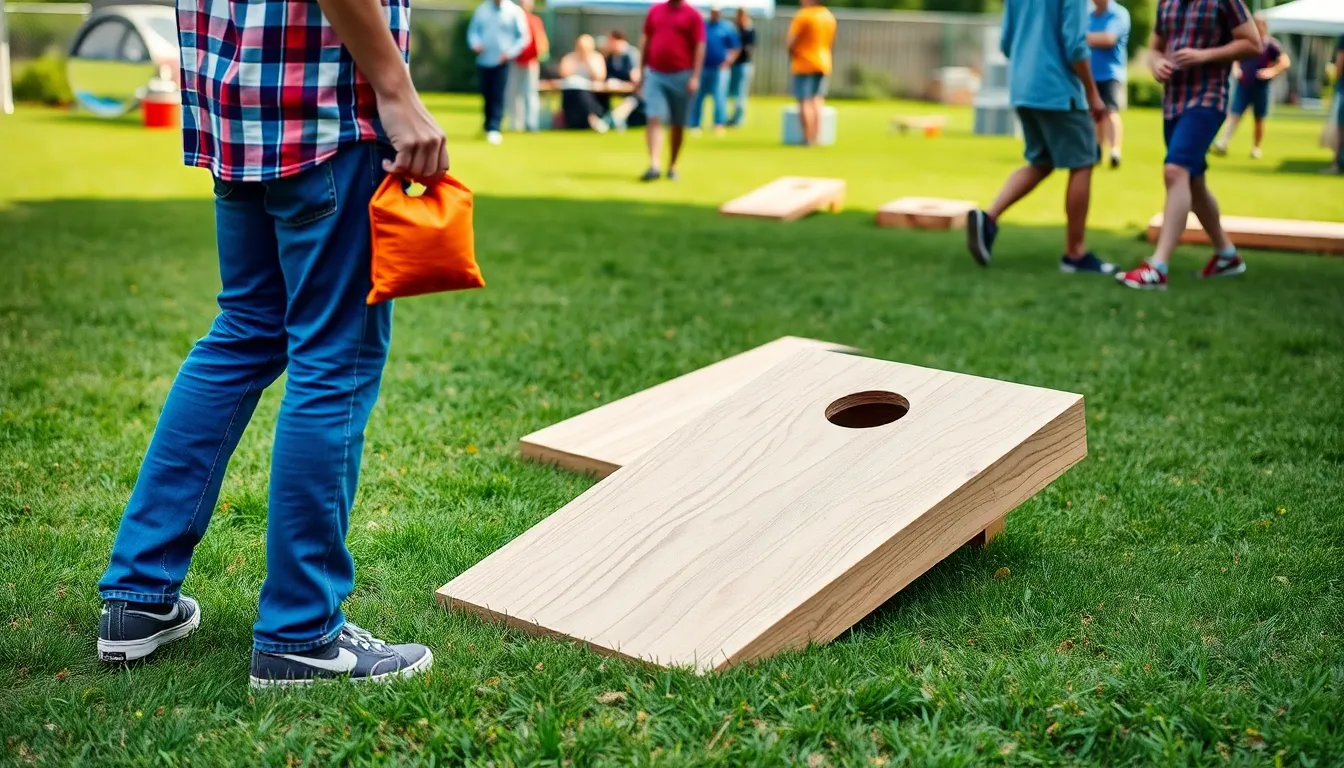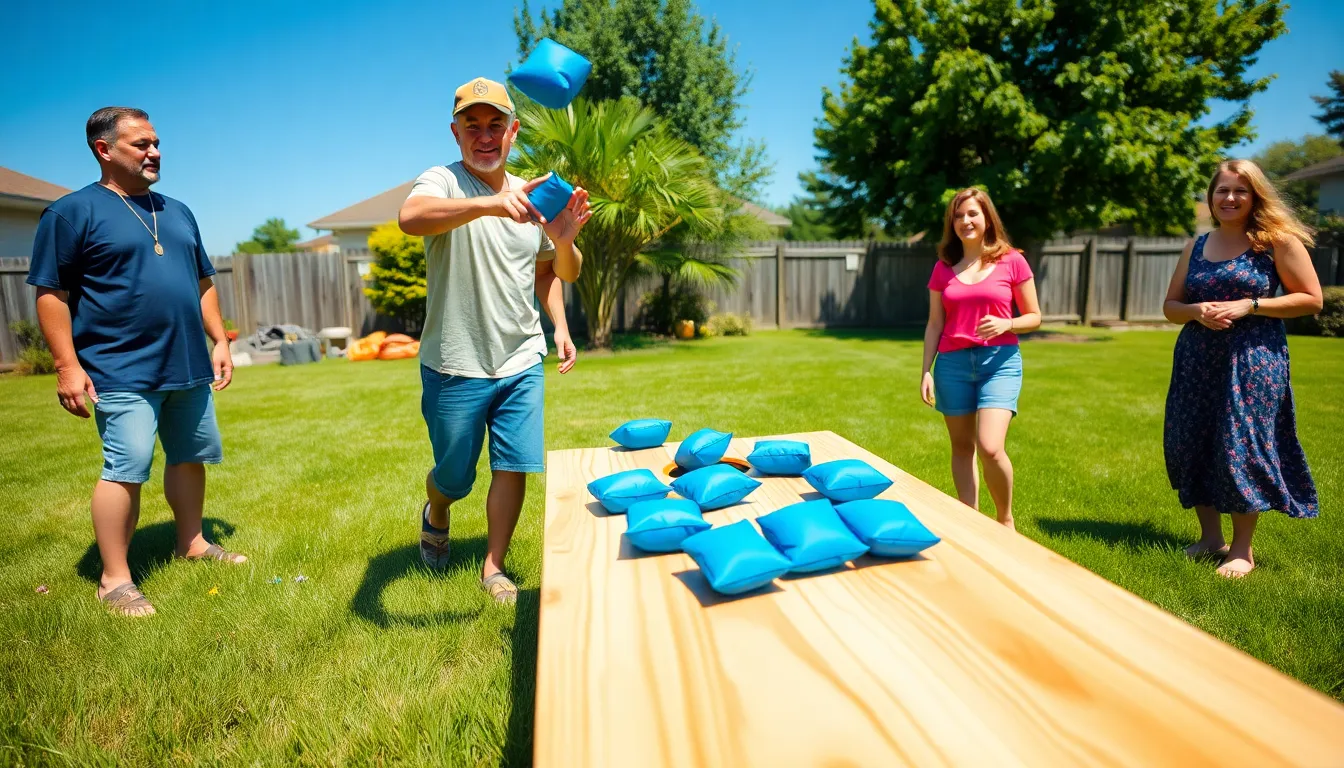Table of Contents
ToggleCornhole is more than just a backyard game; it’s a beloved pastime that brings friends and family together. Mastering the art of throwing cornhole bags can elevate anyone’s game and make those weekend tournaments even more thrilling. Whether you’re a beginner or looking to refine your skills, understanding the fundamentals of throwing technique is essential for success.
Overview of Cornhole
Cornhole, a popular outdoor game, involves tossing bean bags toward a raised platform with a hole. Players or teams earn points by landing bags on the board or in the hole. The game emphasizes skill, precision, and strategy, attracting a diverse range of players, from casual backyard enthusiasts to serious competitors.
Gameplay typically involves two players or teams taking turns throwing bags. A standard cornhole board measures 2 feet by 4 feet with a 6-inch hole centered 9 inches from the top edge. Each player starts with four bags, each weighing 15 to 16 ounces. The first player tosses a bag from behind the foul line, aiming for the board or hole.
Scoring occurs after all bags are thrown. A bag that lands on the board scores 1 point. A bag that lands in the hole scores 3 points. The player or team with the highest score after a round continues playing until reaching 21 points, with various rules governing gameplay variations.
Cornhole fosters camaraderie and engagement, making it a staple at tailgates, barbecues, and tournaments. Mastering the throwing technique enhances gameplay and heightens enjoyment.
Understanding the Equipment

Understanding the equipment is crucial for enhancing cornhole performance. The right bags and board can significantly impact gameplay.
Choosing the Right Bags
Choosing the right bags involves considering size, weight, and material. Regulation bags typically measure 6 inches by 6 inches and weigh between 14 to 16 ounces. Players often prefer bags made of either duck cloth or synthetic material, with duck cloth providing a better grip. Selecting bags that feature different weights allows for personalized throwing techniques. Many players carry multiple sets to adapt to gameplay conditions.
Selecting the Board
Selecting the board entails understanding the dimensions and construction. Official cornhole boards measure 24 inches by 48 inches and stand 12 inches high at the back and 3 inches high at the front. Boards should be made from sturdy materials like plywood. A smooth surface aids in consistent bag sliding, promoting better gameplay. Additionally, ensuring proper board placement, with a distance of 27 feet between front edges, enhances the overall gaming experience.
The Throwing Technique
Mastering the throwing technique significantly enhances a player’s performance in cornhole. Players can improve their accuracy and consistency by focusing on stance, grip, motion, and follow-through.
Stance and Grip
Players should adopt a balanced stance with feet shoulder-width apart, positioning themselves parallel to the board. Proper weight distribution creates stability. The case of the bag involves holding it with a relaxed grip, using the dominant hand, while the fingers should be spread to maintain control. Players often place their thumb on top of the bag for support, ensuring a steady release.
Motion and Follow-Through
The throwing motion starts with the arm raised to shoulder height. A smooth backward motion allows for a natural arc when bringing the arm forward. Players should utilize their legs and core for added power. A consistent follow-through, characterized by the arm extending toward the target, enhances accuracy. Players benefit from releasing the bag with a slight upward flick of the wrist to achieve optimal rotation and trajectory.
Tips for Improving Your Game
Improving cornhole skills requires dedication and strategic practice. These tips can help players refine their techniques and enhance overall performance.
Consistency and Practice
Consistency forms the foundation of successful cornhole gameplay. He or she should practice regularly, focusing on the same throwing technique to develop muscle memory. Players may establish a routine that includes:
- Routine throws: Practice shots from the same distance to build familiarity with the required strength and angle.
- Targeted practice: Focus on hitting specific spots on the board, which improves accuracy.
- Time management: Allocate a set amount of time each practice session to ensure multiple repetitions.
Regular practice not only hones skills but also builds confidence during competitive play.
Analyzing Your Throws
Analyzing throws provides valuable insights into areas for improvement. Players can enhance their games by reviewing each throw’s mechanics. Consider the following approaches:
- Video analysis: Record throwing sessions to observe technique and identify areas for adjustment.
- Feedback: Seek input from peers or experienced players who can offer constructive critiques.
- Stat tracking: Keep track of successful and missed shots to identify patterns and work on weaknesses.
Careful analysis enables players to recognize consistent issues and make necessary adjustments to improve gameplay efficiency.
Mastering the art of throwing cornhole bags can elevate any player’s game. With the right technique and consistent practice players can enjoy both casual and competitive play. The combination of proper stance grip and follow-through is essential for accuracy and power.
As players refine their skills and adapt to different conditions they’ll find that cornhole isn’t just about winning but also about building connections and having fun. Embracing the game’s social aspect can enhance the overall experience making every throw count. Whether at a backyard barbecue or a tournament every player has the potential to improve and enjoy this beloved pastime.








